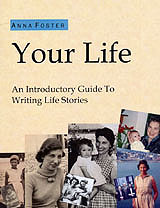
Home > Your Life Writing Guide Contents > Pictures
11. Pictures

In a life story, photographs are as important as words, so include as many family members and friends as possible. Readers often look at the pictures before they read the book.
Try to keep a balanced selection between different periods of your life.
Don't worry too much about quality. Picture editing software can rescue a poor image. Any particularly good ones can be given a prominent position on the page.
Traditionally, pictures were displayed in either one or two sections in the middle of the book, because they were printed on a different paper to the text. These days, pictures can be placed anywhere, as text and pictures are both printed on the same paper.
Digital printing means the book need be no more expensive as a result. A life story of about 150 pages can easily support 50-75 accompanying pictures.
Illustrations other than photographs might include newspaper articles, poems, art works, maps and drawings. Even memorabilia like theatre or sports programmes, ration books or old passports with stamped pages, can bring past events to life. Either you or your printer will scan them in like photographs.
Picture Captions
Each picture needs to be captioned. Place all the pictures in the order in which you would like them to appear and number them on the back in pencil. Now, write a caption for each picture and number it accordingly.
Captions should be fairly short, e.g. 'Johnny at Scarborough Fair in 1966'.
If there is more than one person in the picture, make sure you include a left or right in the caption, eg. 'Johnny, left, and mother, at Scarborough Fair in 1966'.
With a group of people, add a 'From left, Johnny, Helen, etc'. Captions should be clear and explanatory, even humorous.
Keep your pictures and captions together. Mistakes can creep in if the material is not clearly labelled.
Cover Pictures
Choose a couple of pictures for the front and back covers. The front cover picture is the most important one in the book. Assuming the picture is of the subject, decide if you want a formal or an informal pose.
Also, do you want a colour or black and white image? The age of the photograph may dictate your choice.
Choose a second, contrasting picture for the back cover, if you like.
Pictorial Record
If your pictures are of a very high standard, you could produce a pictorial record with descriptive captions. The pictures will need to be interesting and also of good technical quality. In a 100-page book you could include up to 300 pictures.
Exceptionally good pictures could appear on a page of their own, while slightly inferior ones could be presented in a group of four on a page.
Choose a large format such as A4 or similar to show off your pictures to best advantage. Many websites offer good quality off-the-peg photobooks. You can also go to a traditional printer for a bespoke album.
Greater emphasis will be placed on the picture captions, as they are going to tell the story. Give lots of detail about the people, location, date and any personal recollections of the occasion.
Do you have any questions from this section? Please email me and I will try to help you.

